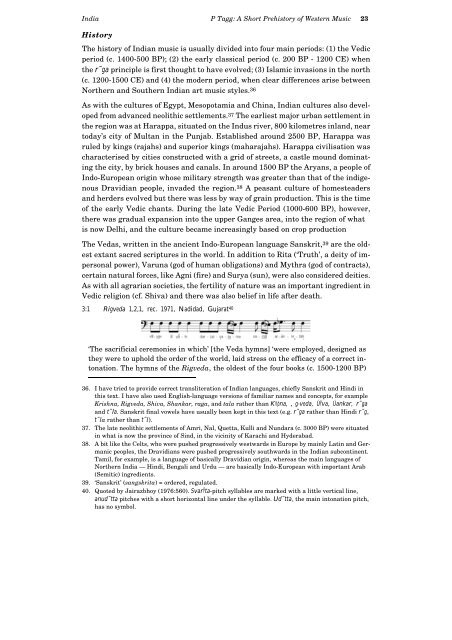A Short Prehistory of Western Music, Chapter 3
A Short Prehistory of Western Music, Chapter 3
A Short Prehistory of Western Music, Chapter 3
You also want an ePaper? Increase the reach of your titles
YUMPU automatically turns print PDFs into web optimized ePapers that Google loves.
India P Tagg: A <strong>Short</strong> <strong>Prehistory</strong> <strong>of</strong> <strong>Western</strong> <strong>Music</strong> 23<br />
History<br />
The history <strong>of</strong> Indian music is usually divided into four main periods: (1) the Vedic<br />
period (c. 1400-500 BP); (2) the early classical period (c. 200 BP - 1200 CE) when<br />
the r˜ga principle is first thought to have evolved; (3) Islamic invasions in the north<br />
(c. 1200-1500 CE) and (4) the modern period, when clear differences arise between<br />
Northern and Southern Indian art music styles. 36<br />
As with the cultures <strong>of</strong> Egypt, Mesopotamia and China, Indian cultures also developed<br />
from advanced neolithic settlements. 37 The earliest major urban settlement in<br />
the region was at Harappa, situated on the Indus river, 800 kilometres inland, near<br />
today’s city <strong>of</strong> Multan in the Punjab. Established around 2500 BP, Harappa was<br />
ruled by kings (rajahs) and superior kings (maharajahs). Harappa civilisation was<br />
characterised by cities constructed with a grid <strong>of</strong> streets, a castle mound dominating<br />
the city, by brick houses and canals. In around 1500 BP the Aryans, a people <strong>of</strong><br />
Indo-European origin whose military strength was greater than that <strong>of</strong> the indigenous<br />
Dravidian people, invaded the region. 38 A peasant culture <strong>of</strong> homesteaders<br />
and herders evolved but there was less by way <strong>of</strong> grain production. This is the time<br />
<strong>of</strong> the early Vedic chants. During the late Vedic Period (1000-600 BP), however,<br />
there was gradual expansion into the upper Ganges area, into the region <strong>of</strong> what<br />
is now Delhi, and the culture became increasingly based on crop production<br />
The Vedas, written in the ancient Indo-European language Sanskrit, 39 are the oldest<br />
extant sacred scriptures in the world. In addition to Rita (‘Truth’, a deity <strong>of</strong> impersonal<br />
power), Varuna (god <strong>of</strong> human obligations) and Mythra (god <strong>of</strong> contracts),<br />
certain natural forces, like Agni (fire) and Surya (sun), were also considered deities.<br />
As with all agrarian societies, the fertility <strong>of</strong> nature was an important ingredient in<br />
Vedic religion (cf. Shiva) and there was also belief in life after death.<br />
3:1 Rigveda 1,2,1, rec. 1971, Nadidad, Gujarat 40<br />
‘The sacrificial ceremonies in which’ [the Veda hymns] ‘were employed, designed as<br />
they were to uphold the order <strong>of</strong> the world, laid stress on the efficacy <strong>of</strong> a correct intonation.<br />
The hymns <strong>of</strong> the Rigveda, the oldest <strong>of</strong> the four books (c. 1500-1200 BP)<br />
36. I have tried to provide correct transliteration <strong>of</strong> Indian languages, chiefly Sanskrit and Hindi in<br />
this text. I have also used English-language versions <strong>of</strong> familiar names and concepts, for example<br />
Krishna, Rigveda, Shiva, Shankar, raga, and tala rather than K®þna, ‚g-veda, Ÿva, ankar, r˜ga<br />
and t˜la. Sanskrit final vowels have usually been kept in this text (e.g. r˜ga rather than Hindi r˜g,<br />
t˜la rather than t˜l).<br />
37. The late neolithic settlements <strong>of</strong> Amri, Nal, Quetta, Kulli and Nundara (c. 3000 BP) were situated<br />
in what is now the province <strong>of</strong> Sind, in the vicinity <strong>of</strong> Karachi and Hyderabad.<br />
38. A bit like the Celts, who were pushed progressively westwards in Europe by mainly Latin and Germanic<br />
peoples, the Dravidians were pushed progressively southwards in the Indian subcontinent.<br />
Tamil, for example, is a language <strong>of</strong> basically Dravidian origin, whereas the main languages <strong>of</strong><br />
Northern India — Hindi, Bengali and Urdu — are basically Indo-European with important Arab<br />
(Semitic) ingredients.<br />
39. ‘Sanskrit’ (sangskrita) = ordered, regulated.<br />
40. Quoted by Jairazbhoy (1976:560). SvarŸta-pitch syllables are marked with a little vertical line,<br />
anud˜tta pitches with a short horizontal line under the syllable. Ud˜tta, the main intonation pitch,<br />
has no symbol.














